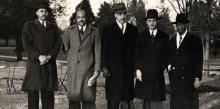Story by the Visitor Staff
News of Lucy Byard’s death sent shock waves through the Seventh-day Adventist Church, especially among its 16,000 African-American members.
The rejection and her subsequent death was the “last straw” and a “slap in the face” in a “series of denials, negations, cold shoulders and brush-offs that the black membership had experienced for decades,” says Alvin Kibble, vice president of the North American Division (NAD) and a former Allegheny East Conference president.
In a 2018 NAD article titled “Organization Honors Memory of Lucille Byard,” Debbie Michel wrote, “Byard’s death triggered a new level of activism as never before seen. A letter from Byard’s Long Island, N.Y., congregation was sent to the General Conference (GC) president threatening a lawsuit. One group comprised of a number of highly educated and articulate women met in the back room of a Washington, D.C., bookstore and began to organize.
According to an account in Calvin Rock’s 2018 book Protest and Progress, ‘They passed the hat to help on the telephone bill and began calling various persons to apprize them of their actions.’ Before long, the Committee for the Advancement of World-Wide Work Among Colored Seventh-day Adventists,
which advocated for equal rights in the church, was formed.”
After many discussions and meetings between black leaders and GC officers, members of the 1944 Spring Meeting
of GC Executive Committee voted, “We recommend:
-
That in unions where the colored constituency is considered by the union conference committee to be sufficiently large, and where the financial income and territory warrant, colored conferences be organized.
-
That these colored conferences be administered by colored officers and committees.
-
That in the organization of these conferences the present conference boundaries within each union need not be recognized.
- That colored conferences sustain the same relation to their respective union conferences as do the white conferences (Actions of the Spring Meeting of the General Conference Committee, April 10–16, 1944, pp. 15, 16).
Over the next two-and-a-half years, seven Regional Conferences were established, including the Allegheny Conference in December 1944, which later became the Allegheny East and Allegheny West conferences in the Columbia Union Conference. The Lake Region Conference in the Lake Union Conference was the first to begin functioning on January 1, 1945.

